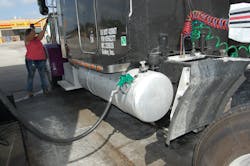U.S. fuel prices down again, but still higher vs. 2017
Average diesel prices dropped in every region of the country this week, according to data tracked by the Energy Information Administration (EIA); a drop mirrored by gasoline prices as well except for the Midwest and West Coast.
The U.S. average retail pump price for diesel dipped 1.6 cents this week to $2.976 per gallon, EIA noted. Yet that is 41.2 cents per gallon higher compared to the same week in 2017, according to the agency’s numbers.
Diesel prices dropped in every region of the U.S. this week except for California, where they stayed flat at week-over-week at $3.652 per gallon. Only three other regions shared with California diesel prices above the $3 per gallon mark:
- The West Coast: down 6/10ths of a penny to $3.386 per gallon, which changes to a dip of 1.2 cents to $3.052 per gallon with California removed from the mix.
- The Central Atlantic: down 1.9 cents to $3.221 per gallon
- New England: down 1.9 cents to $3.107 per gallon
The U.S. average retail pump price for gasoline fell 1/10th of a penny this week to $2.559 per gallon, though that is 23.6 cents per gallon higher compared to the same week in 2017, EIA noted.
Gasoline prices dropped in every region of the U.S. this week except for two: the Midwest, where prices jumped 1.1 cents to $2.439 per gallon and the West Coast, where prices increased 2.9 cents to $3.170 per gallon. With California removed from the mix, gasoline prices on the West Coast increased 1.7 cents to $2.787 per gallon, EIA said.
In a related report, the agency noted that estimated ethanol production margins at U.S. corn ethanol plants averaged 22 cents per gallon in 2017 – the fifth consecutive year margins averaged more than 20 cents/gal, which helped drive “consistent” ethanol production growth to estimated 1.032 million barrels per day (b/d) in 2017, marking a fifth consecutive record level of annual production.
In the U.S., ethanol is primarily used as a blending component in the production of motor gasoline and mainly blended in volumes up to 10% ethanol, known as E10. Ethanol demand is highly dependent on motor gasoline consumption, and ethanol production has been driven higher in recent years because of the Renewable Fuel Standard (RFS), EIA said – a program administered by the U.S. Environmental Protection Agency that mandates the blending of biofuels into the nation’s fuel supply. Although demand for higher ethanol blends such as E15 and E85 remains limited, low ethanol prices and increasing RFS targets have created favorable blending conditions for these higher ethanol blends.
In its latest Short-Term Energy Outlook, EIA forecasts that continued growth in ethanol production and limited export growth through 2019 will lead to increases in domestic consumption of ethanol by way of limited higher-level ethanol blend growth beyond E10. U.S. ethanol consumption, which increased by 1% in 2017, is expected to increase by an average of 1% through 2019, resulting in an estimated ethanol blend percentage of gasoline that increases from slightly more than 10.1% in 2017 to about 10.3% by 2019.
